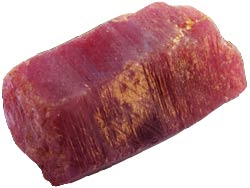Metaphysical of Corundum, Physical properties of Corundum
|
CORUNDUM
Corundum is a crystalline form of aluminium oxide (Al2O3) with traces of iron, titanium and chromium. It is a rock-forming mineral. It is one of the naturally clear transparent materials, but can have different colors when impurities are present. Transparent specimens are used as gems, called ruby if red, while all other colors are called sapphire.
The name "corundum" is derived from the Tamil word "kuruntam" meaning "ruby", itself derived from the Sanskrit "kuruvinda".
Because of corundum`s hardness (pure corundum is defined to have 9.0 Mohs), it can scratch almost every other mineral. It is commonly used as an abrasive, on everything from sandpaper to large machines used in machining metals, plastics and wood. Some emery is a mix of corundum and other substances, and the mix is less abrasive, with a lower average hardness near 8.0.
In addition to its hardness, corundum is unusual for its density of 4.02 g/cm3, which is very high for a transparent mineral composed of the low atomic mass elements aluminium and oxygen.
When someone lists the most famous gemstones such as diamond, topaz, aquamarine, emerald and garnet, corundum does not usually get mentioned. However, its two varieties are sure to be on any list of gemstones. The red variety of corundum is known as ruby and all the other colors of corundum are known as sapphire.
Corundum is a raw form of ruby and sapphire.
Corundum is the second hardest natural mineral known to science. The hardest mineral, diamond is still four times harder than corundum. The hardness of corundum can be partially attributed to the strong and short oxygen-aluminum bonds. These bonds pull the oxygen and aluminum atoms close together, making the crystal not only hard but also quite dense for a mineral made up of two relatively light elements.
Physical properties of Corundum: Category: Oxide mineral - hematite group
Chemical formula: Aluminium oxide, Al2O3 Strunz classification: IV/C.04-10 Dana classification: 4.3.1.1 Crystal symmetry Trigonal: (32/m) Unit cell: a = 4.75 Å, c = 12.982 Å; Z=6 Color: Colorless, gray, brown; pink to pigeon-blood-red, orange, yellow, green, blue to cornflower blue, violet; may be color zoned, asteriated mainly grey and brown Crystal habit: Steep bipyramidal, tabular, prismatic, rhombohedral crystals, massive or granular Crystal system: Trigonal (Hexagonal Scalenohedral) Symbol: (32/m) Space group: R3c Twinning: Polysynthetic twinning common Cleavage: None - parting in 3 directions Fracture: Conchoidal to uneven Mohs scale hardness: 9 Luster: Adamantine to vitreous Streak: White Diaphaneity: Transparent, translucent to opaque Specific gravity: 3.95-4.10 Optical properties: Uniaxial (-) Refractive index: n? = 1.767-1.772 n? = 1.759-1.763 Pleochroism: None Melting point: 2044 °C Fusibility: Infusible Solubility: Insoluble May alter to mica on surfaces causing a decrease in hardness
Other characteristics: May fluoresce or phosphoresce under UV
Metaphysical guide of Corundum: Corundum promotes insight to the unknown, enhances one`s intuitive awareness. Corundum stimulates ambition and confidence, subdues emotions and helps one to release anger in a positive manner. Sources: This information does not intend to serve as medical advice, cure any diseases, and should not be relied upon in your health-related decision making. This information is available to assist in expanding your understanding of prevailing beliefs in the metaphysical fields. |
The Corundum products that may help you

